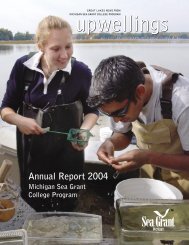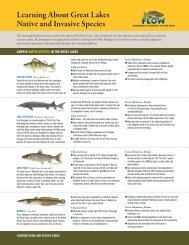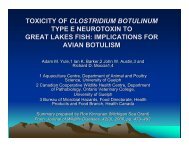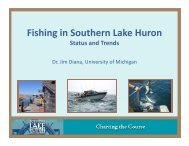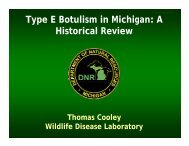VIRAL HEMORRHAGIC SEPTICEMIA (VHS) IN THE GREAT LAKES
VIRAL HEMORRHAGIC SEPTICEMIA (VHS) IN THE GREAT LAKES
VIRAL HEMORRHAGIC SEPTICEMIA (VHS) IN THE GREAT LAKES
Create successful ePaper yourself
Turn your PDF publications into a flip-book with our unique Google optimized e-Paper software.
Muskellunge is one of at least 18 fish species<br />
in the Great Lakes affected by <strong>VHS</strong>.<br />
Viral Hemorrhagic Septicemia (<strong>VHS</strong>)<br />
in the Great Lakes<br />
<strong>VHS</strong> is a viral disease affecting more than 40 species of marine and<br />
freshwater fish in North America. Typically a marine fish virus, most<br />
recently <strong>VHS</strong> has emerged in 18 species of fish in the Great Lakes region<br />
of the United States and Canada. The <strong>VHS</strong> isolate found in the Great Lakes<br />
Basin is most similar to the <strong>VHS</strong> isolate previously found in the Canadian<br />
Maritime Region in Eastern North America and has been labeled Type IVb.<br />
<strong>VHS</strong> is not a human pathogen. According to<br />
the Michigan Department of Natural Resources<br />
(MDNR), there are no concerns with respect<br />
to <strong>VHS</strong> and human health, and the virus<br />
cannot infect humans if they eat fish with the<br />
pathogen. <strong>VHS</strong> is, however, an international<br />
reportable animal disease that requires<br />
notification of and action by the United States<br />
Department of Agriculture — Animal and<br />
Plant Health Inspection Service (USDA-APHIS),<br />
Canadian Food Inspection Agency (CFIA), and<br />
the International Organization for Animal<br />
Health (OIE).<br />
Where has <strong>VHS</strong> been found?<br />
In the Great Lakes region, <strong>VHS</strong> has been<br />
confirmed in fish collected from the St. Clair<br />
River, Lake St. Clair, Lake Erie, Niagara River,<br />
Lake Ontario (Bay of Quinte, Ontario and<br />
Rochester, NY areas), the St. Lawrence River,<br />
and most recently Lake Huron (near Cheboygan,<br />
Rogers City and Alpena).<br />
It is not known how <strong>VHS</strong> virus was transferred<br />
to the Great Lakes or how long it has been in<br />
the ecosystem. It is likely to have mutated<br />
from a marine form and become newly<br />
pathogenic to some freshwater fish species.<br />
Ballast water discharge is considered a likely<br />
means of introduction, given the distribution<br />
of <strong>VHS</strong> in the lakes and its likely origin from the<br />
Atlantic coast.<br />
What fish species in the Great Lakes<br />
are affected by <strong>VHS</strong>?<br />
<strong>VHS</strong> has been confirmed in at least 18 fish<br />
species in the Great Lakes, according to<br />
the MDNR.<br />
<strong>VHS</strong> has caused large fish kills in freshwater<br />
drum (lakes Ontario and Erie), muskellunge<br />
(Lake St. Clair), round gobies (Lake Ontario),<br />
gizzard shad (St. Clair River), white bass (Lake<br />
Erie) and yellow perch (lakes Erie and Lake St.<br />
Clair). <strong>VHS</strong> has also been confirmed in smaller<br />
mortality events in lake whitefish (Lake Huron),<br />
walleye (Lake Huron), smallmouth bass (Lake<br />
St. Clair), black crappie (Lake St. Clair), and<br />
bluegill (Lake St. Clair).<br />
According to the MDNR, a number of other<br />
species have been identified as carrying<br />
<strong>VHS</strong> although mortalities have not been seen<br />
in these species. These include: Chinook salmon<br />
(Lake Huron); rock bass (Lake St. Clair); silver<br />
redhorse (Lake St. Clair); northern pike (Lake<br />
St. Clair); shorthead redhorse (Lake St. Clair);<br />
burbot (Lake Ontario) silver redhorse (Lake<br />
St. Clair); spottail shiners (Lake St. Clair),<br />
and emerald shiners (Lake Erie and the<br />
Niagara River).<br />
www.miseagrant.umich.edu<br />
Offices<br />
Ann Arbor<br />
University of Michigan<br />
(734) 763-1437<br />
East Lansing<br />
Michigan State University<br />
(517) 353-9568<br />
Northeast:<br />
(989) 984-1056<br />
Northwest:<br />
(231) 922-4628<br />
Southeast:<br />
(313) 410-9431<br />
(586) 469-7431<br />
Southwest:<br />
(616) 846-8250<br />
Upper Peninsula:<br />
(906) 226-3687<br />
Great Lakes Regional:<br />
(734) 741-2287<br />
Michigan Sea Grant College Program<br />
Michigan Sea Grant is a cooperative program of<br />
the University of Michigan and Michigan State<br />
University. Funding: NOAA-National Sea Grant<br />
College Program with matching funds from<br />
the University of Michigan and Michigan State<br />
University. Michigan State University and the<br />
University of Michigan are equal opportunity/<br />
affirmative action institutions.<br />
Dr. James Winton, USGS Illustration: Damstra<br />
07-700 JD
www.miseagrant.umich.edu<br />
How does <strong>VHS</strong> affect fish?<br />
<strong>VHS</strong> Type IVb is most active in cold water (less than 15 degrees C),<br />
which is why mortalities are often seen in the spring. Fish exhibit<br />
hemorrhaging of the skin including large, red patches particularly<br />
on the sides and anterior portion of the head. However, the<br />
MDNR notes that infected fish will sometimes exhibit very minor<br />
external hemorrhaging or no external signs. Internally, organs are<br />
often congested with multiple hemorrhages in the liver, spleen,<br />
and intestines. The cause of death is usually internal organ failure,<br />
particularly the kidneys, or the inability to osmoregulate. Sick fish<br />
will often appear listless, swim in circles, or hang just below the<br />
surface, according to MDNR staff observations. Fish that survive<br />
infection can be carriers of the virus throughout their lives. <strong>VHS</strong> is<br />
transmitted by urine, feces, and reproductive fluids.<br />
What is Michigan DNR doing about <strong>VHS</strong>?<br />
Since <strong>VHS</strong> can cause large scale mortalities of valuable adult fish<br />
and it has a wide range of potential carriers, the MDNR stresses<br />
that it is critical to make every attempt to contain the pathogen<br />
and not allow a rapid spread of the disease to all Great Lakes and<br />
inland waters. Once a pathogen gets into a wild fish community,<br />
it is impossible to effectively eliminate, and control is unlikely. The<br />
MDNR is evaluating all potential human-caused means of spread<br />
and is taking appropriate steps to reduce this likelihood.<br />
Michigan Sea Grant Initiatives<br />
Sea Grant extension educators are working with aquaculture and<br />
baitfish industries in the Midwest to prevent the spread of <strong>VHS</strong><br />
through AIS-HACCP. AIS-HACCP is a self-inspection system for<br />
reducing the risk of spreading aquatic invasive species through<br />
aquaculture, hatchery, scientific, natural resource, and baitfish<br />
harvesting activities. This adaptable system is based on HACCP<br />
(Hazard Analysis and Critical Control Point) methods required for<br />
the seafood industry and builds on Sea Grant’s success in assisting<br />
industry compliance. AIS-HACCP offers an approach that could<br />
protect fisheries from the further spread of <strong>VHS</strong> while allowing<br />
these businesses to survive.<br />
What can anglers and boaters do to help stop the<br />
spread of <strong>VHS</strong>?<br />
Anglers and boaters can help prevent the spread of fish<br />
diseases and other aquatic invasive species by taking the<br />
following steps:<br />
n Clean boats, trailers, and other equipment thoroughly<br />
between fishing trips to keep from transporting<br />
undesirable fish pathogens and organisms from one<br />
water body to another. Take special care to clean fishing<br />
equipment when fishing known locations of <strong>VHS</strong>. A light<br />
bleach solution is an excellent disinfectant for cleaning<br />
equipment (1 cup for 10 gallons of water).<br />
n After cleaning, allow boats, trailers and other equipment<br />
to fully dry for four to six hours in the sun.<br />
n Do not move fish or fish parts from one body of water<br />
to another.<br />
n Do not release live bait into any water body.<br />
n Handle fish as gently as possible if you intend to release<br />
them, and release them as quickly as possible.<br />
n Refrain from hauling fish for long periods in live wells<br />
if you intend to release them.<br />
n Report unusual numbers of dead or dying fish to<br />
Michigan Department of Natural Resources Fisheries<br />
Division offices.<br />
n Educate other anglers about the measures they can take<br />
to prevent the spread of fish diseases and other aquatic<br />
nuisance species.<br />
Sources:<br />
Michigan Department of Natural Resources, news release, 2007. See: www.michigan.gov/dnr/0,1607,7-153-10371_10402-160980--,00.html<br />
NOAA <strong>VHS</strong> Fact sheet: See: www.glerl.noaa.gov/res/Programs/ncrais/resources/<strong>VHS</strong>V-factsheet.pdf<br />
USDA: Viral Hemorrhagic Septicemia in the Great Lakes, July 2006 Emerging Disease Notice.<br />
See: www.aphis.usda.gov/vs/ceah/cei/taf/emergingdiseasenotice_files/vhsgreatlakes.htm



